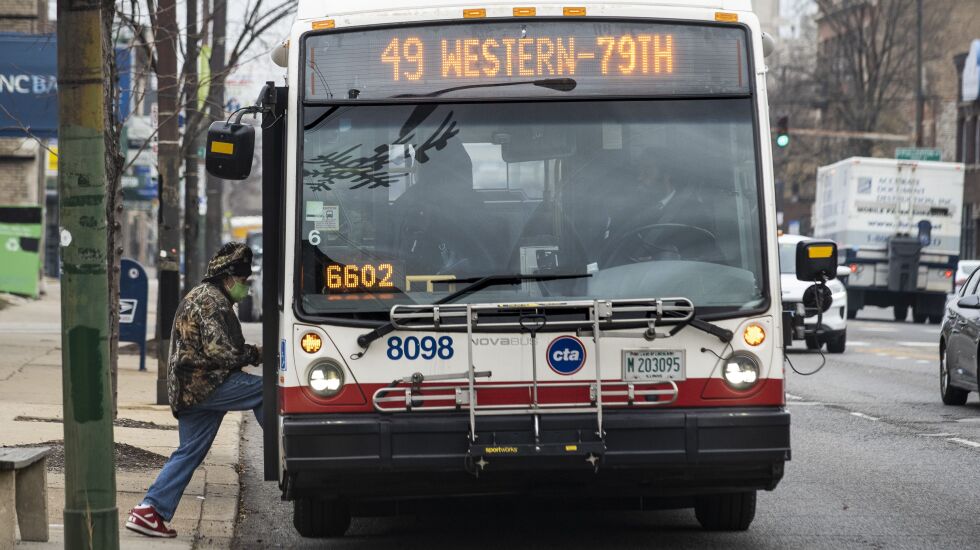
Drivers who block bus and bike lanes could have their license plates captured by cameras installed on the exterior of CTA buses — triggering tickets that would arrive by mail — under a proposed crackdown aimed at speeding up bus service.
Nearly 20 years after a similar CTA experiment with surveillance cameras that ultimately failed, Ald. Daniel La Spata (1st) wants to try it again.
At Wednesday’s City Council meeting, La Spata introduced an ordinance that would empower the city comptroller to forge an intergovernmental agreement with the RTA and CTA “for the purpose of procuring necessary cameras and maintenance” equipment “for the enforcement of traffic violations.”
La Spata argued that motorists are parking with impunity in bus and bike lane and at bus stops. The defiance is so rampant, it’s slowing down CTA bus service and defeating the purpose of bus lanes at the same time the CTA is struggling to fill bus driver vacancies that are creating additional service headaches.
By the time the city responds to a 311 complaint about motorists and delivery trucks illegally parked in bus and bike lanes, the offending motorist or delivery truck driver often is already gone, La Spata said.
That’s why he wants to resurrect the idea of using surveillance cameras strategically positioned on the exterior of CTA buses.
“If you’re taking the 66 Chicago [Avenue] bus down the street during rush hour or during a lot of hours of the day, it’s a major problem. It renders a lot of these bus-only lanes dysfunctional,” La Spata told the Sun-Times.
“We’re going to see a lot more efficient service for CTA riders [by] being able to issue citations in a timely fashion [in] a way ... that is automated and camera-based. It would be really beneficial in terms of making sure we’re keeping the public right of way clear” for CTA buses.
La Spata’s ordinance would empower the CTA to install surveillance cameras on the exterior of every one of its 2,200 buses.
That is, if the mass transit agency can find the money to purchase exterior cameras at a time when ridership remains at roughly half of what it was before the pandemic.
“Every ordinance turns into a substitute ordinance. We want to really use this as a jumping-off point to have that conversation and to figure out what can be the most effective and responsible,” he said.
London pioneered the idea of using exterior bus cameras to nail motorists blocking bus lanes and at bus stops.
In 2002, then-CTA President Frank Kruesi proposed that Chicago follow London’s lead, and the City Council authorized the crackdown at the same time that red-light cameras made their debut in Chicago.
But the crackdown got off to a slow and rocky start.
It took the CTA seven months to work out ticketing logistics with the city’s Department of Revenue.
And the experiment was abruptly ended after blurry camera images and other technical trouble aboard just two CTA buses spared all but 400 of the 2,700 motorists caught blocking bus stops and bus lanes during a five-month rush-hour experiment.
CTA spokesperson Catherine Hosinski responded to La Spata’s proposal to try again by saying, “State legislation would be required to give CTA the authority to do bus camera enforcement.”
“CTA is still exploring this legislation,” Hosinski wrote in a statement.
“As you know, CTA conducted a pilot for bus enforcement cameras back in 2005 but did not move forward with a program at that time.”
Days after a divided City Council voted to maintain the ticketing threshold for Chicago speed cameras at 6 mph over the posted speed limit, La Spata’s ordinance also proposed even higher fines.
Under the plan, motorists caught going more than 10 mph but under 15 mph over the limit would be slapped with a $150 fine, up from $35.
Speeds over 15 mph but under 20 mph over the limit would trigger a $300 fine, triple the existing penalty.
And if the recorded speed is 20 miles over the limit, the fine would be $500.







